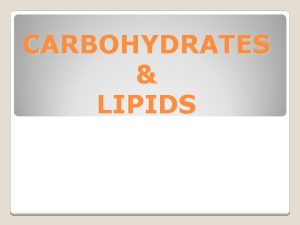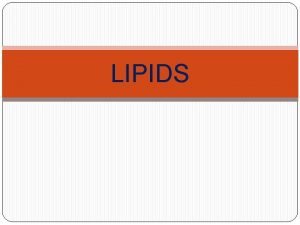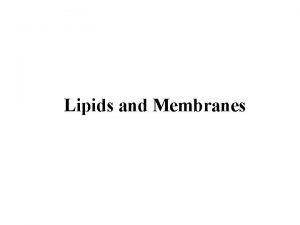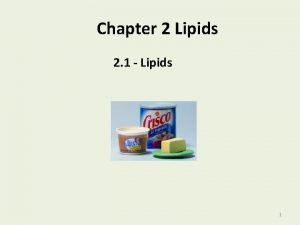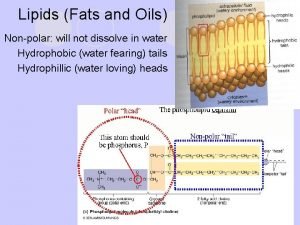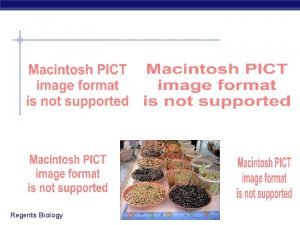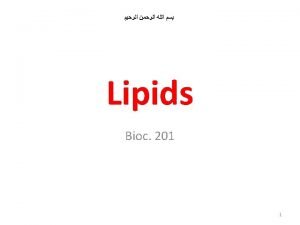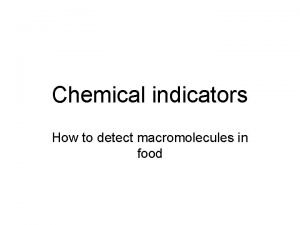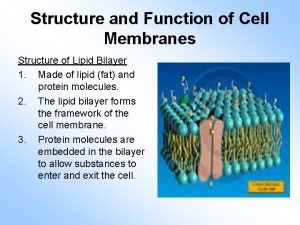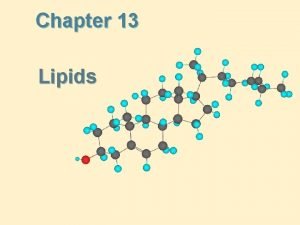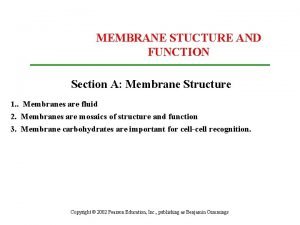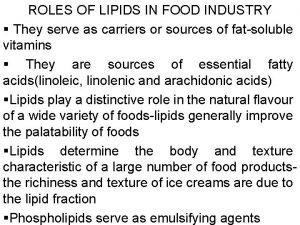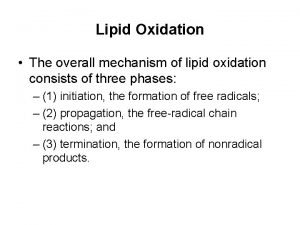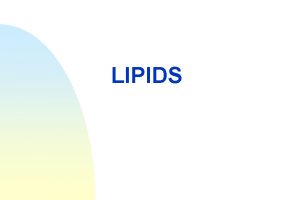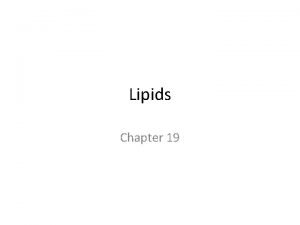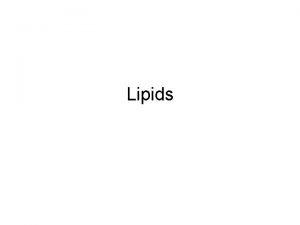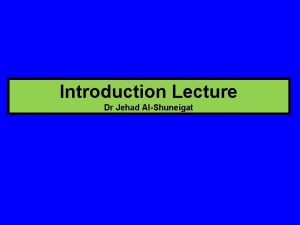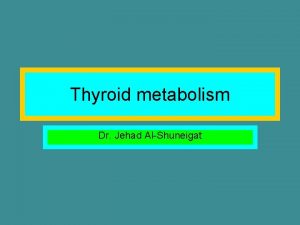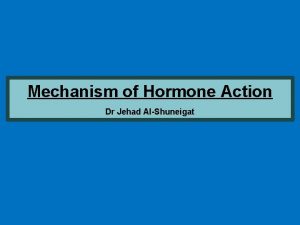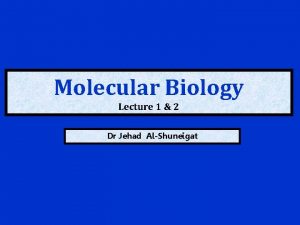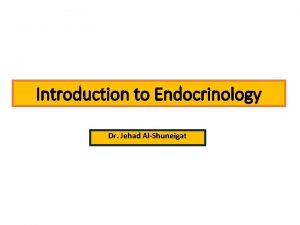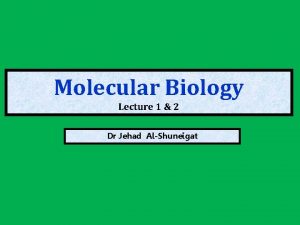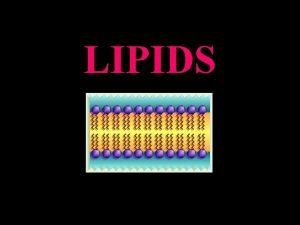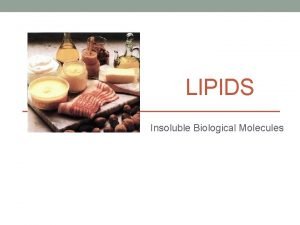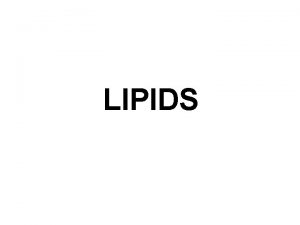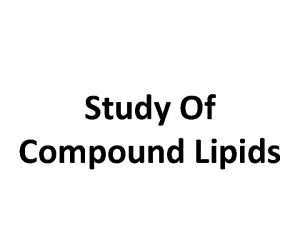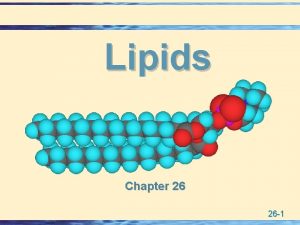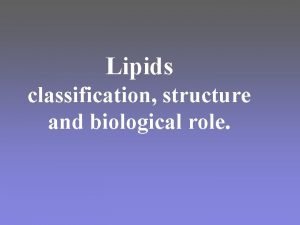Lipids 2 Dr Jehad AlShuneigat Triacylglycerols Triacylglycerols also


















- Slides: 18

Lipids (2) Dr Jehad Al-Shuneigat

Triacylglycerols • Triacylglycerols (also called triglycerides) consist of a glycerol esterified with three fatty acids. • Triacylglycerols are the main components of animals fat mostly found in adipose tissue; they are also the main components of vegetable oils. • Triacylglycerols makes 90% - 95% of dietary fat. • Glycerol (or glycerine) is colorless, viscous, and sweettasting with a molecular formula CH 2 OH-CH 2 OH and because of its three hydroxyl groups glycerol is soluble in water. The three hydroxyl groups of glycerol are each esterified typically by fatty acids which is then is known as triacylglycerol. • If all three fatty acid groups are the same, the molecule is called a simple triacylglycerol and if different fatty acids it is called mixed triacylglycerols. • Most natural plant and animal fat is composed of mixtures of simple and mixed triacylglycerols.

• Triacylglycerols in animals are found primarily in the adipose tissue (body fat), which serves as a storage site for lipids. • Adipose tissue triacylglycerols are derived from two sources; dietary lipids and triacylglycerols synthesized in the liver. • Triacylglycerols yield large amounts of energy in the oxidative reactions of metabolism. Complete oxidation of 1 g of triacylglycerols yields about 38 k. J of energy, whereas proteins and carbohydrates yield only about 17 k. J/g.


An ester is formed when a carboxylic acid an alcohol combine, splitting out water


Phospholipids • Phospholipids are amphipathic lipids found mainly in cell membrane. • There are two classes of phospholipids: A- Phosphoglycerides are phospholipids that have glycerol as a backbone. B- Sphingolipids are phospholipids that contain sphingosine as a backbone. • Both classes are found as structural components of membranes, and both play a role in the generation of lipid-signalling molecules.

A. Phosphoglycerides • Function: component of cell membranes. • The hydroxyl groups at C-1 and C-2 of glycerol are esterified to the carboxyl groups of the two fatty acid chains. • The C-3 hydroxyl group of the glycerol backbone is esterified to phosphoric acid. • When no further additions are made, the resulting compound is phosphatidate the simplest phosphoglyceride and key intermediate in the biosynthesis of the other phosphoglycerides. • The common alcohol moieties of phosphoglycerides are the amino acid serine to form phosphatidylserine, choline to form phosphatidylcholine (lecithin), and the inositol to form phosphatidylinositol.

serine to form phosphatidylserine, (Function cycle signaling) choline to form phosphatidylcholine (function cell signaling, pulmonary surfactant) inositol to form phosphatidylinositol (function cell signaling) Phosphatidate (Phosphatidic acid) the parent compound for phosphoglycerides

phosphatidate

B. Sphingolipids Found in cell membranes of nerve cells particularly important in forming the myelin sheath. The major component of sphingolipids 1 - Sphingosine an 18 -carbon amino alcohol with an unsaturated hydrocarbon chain. 2 - Fatty acid is attached in amide linkage (bond between COOH-group of the fatty acid and NH 2– group) to the -NH 2 on C-2 of the sphingosine the resulting compound is a ceramide. Ceramide is the fundamental structural unit to all sphingolipids.

In the structure of ceramide when X is phosphocholine the result is sphingomyelin Carbohydrate groups attach to ceramide, forming glycolipids (Glycosphingolipid s) such as the cerebrosides, globosides, and gangliosides.

• There are three major types of sphingolipids: • 1 - Sphingomyelins have a phosphorylcholine linked to ceramide. Sphingomyelins is a component of the myelin sheath • 2 - Cerebrosides (Neutral glycolipids) found in cell membrane, they contain a monosaccharide (glucose or galactose) (glucosylceramide (Glc. Cer)) or galactose (galactosylceramide (Gal. Cer)). • 3 - Gangliosides are more complex glycosphingolipids containing oligosaccharide connected to ceramide. • The head of gangliosides possesses a net negative charge at neutral p. H because of the presence of sialic acid in the oligosaccharide head group. They are present in the outer layer of the plasma membrane and are important as antigens (sites of biological recognition at cellular level) and cell receptors. • Several genetic diseases resulting from the absence of specific enzymes which breakdown the glycolipids including Tay-Sachs disease and Krabbe disease.

Waxes • Waxes are esters of long-chain fatty alcohols (combination of a fatty acid with an alcohol) with long-chain fatty acids. • Fatty acids found in waxes are usually saturated. • The alcohols found in waxes may be saturated or unsaturated and may include sterols, such as cholesterol. • Waxes are water-insoluble due to the weakly polar nature of the ester group. • Waxes confers water-repellant character to animal skin, to the leaves of certain plants, and to bird feathers. The shiny surface of a polished apple results from a wax coating.

• An example of a wax: Oleoyl alcohol is esterified to stearic acid in this case

Cholesterol • Cholesterol is a waxy, whitish-yellow fat. • Our bodies need cholesterol to make cell membranes, steroid hormones (like testosterone and estrogen), vitamin D, and bile acids needed to digest and absorb fats. • Our liver and intestines make about 80% of the cholesterol that our body needs and only about 20% of cholesterol comes from the foods you eat. • Only animals cells makes cholesterol. • Plants do not make cholesterol • Cholesterol has no caloric value for us because we cannot oxidize the carbons in its complex ring structure. • High concentrations of cholesterol in the blood, particularly low density lipoproteins (LDL), contribute to the formation of atherosclerotic plaques. These plaques (fatty deposits on arterial walls) are associated with heart attacks and strokes. A high content of saturated fat in the diet tends to increase circulatory levels of LDL cholesterol and contributes to the development of atherosclerosis.

Cholesterol • Cholesterol made up of • Four fused hydrocarbon rings (A, B, C, and D, called the "steroid nucleus") • Eight-carbon branched hydrocarbon chain attached to C 17 of the D ring. • Ring A has a hydroxyl group at C-3, and ring B has a double bond between C-5 and C-6.

Eicosanoids “Eicosa” is the Greek word for the number 20. Eicosanoids are synthesized from polyunsaturated fatty acids with 20 carbon atoms. Eicosanoids include: • prostaglandins (PG), thromboxanes (TX), and leukotrienes (LT). • prostaglandins and Leukotrienes: play important role in inflammation response. • Thromboxanes: found in blood platelets, function blood clotting and constriction of blood vessels. • The most common precursor of the eicosanoids is arachidonic acid a polyunsaturated fatty acid with 20 carbons and 4 double bonds. • Arachidonic acid cannot be synthesized in the body, the diet must contain arachidonic acid or the precursor from which arachidonic acid can be produced which is linoleic acid.
 Triacylglycerols
Triacylglycerols Classes of lipids
Classes of lipids Triacylglycerols
Triacylglycerols Glycerophospholipid structure
Glycerophospholipid structure Are lipids hydrophobic
Are lipids hydrophobic Ethanol emulsion test for lipids
Ethanol emulsion test for lipids Lipids
Lipids Classes of lipids
Classes of lipids How are indicators used to detect macromolecules?
How are indicators used to detect macromolecules? Lipids cell membrane function
Lipids cell membrane function Complex lipids
Complex lipids Stucture of cell membrane
Stucture of cell membrane Uses of lipids in food industry
Uses of lipids in food industry Apa itu tbhq
Apa itu tbhq Simple fats
Simple fats Classes of lipids
Classes of lipids Fats and lipids
Fats and lipids Facts about lipids
Facts about lipids Characteristics of lipids
Characteristics of lipids
